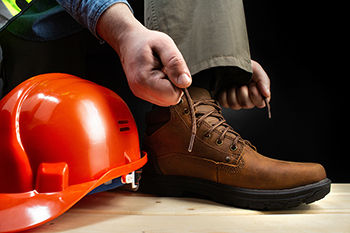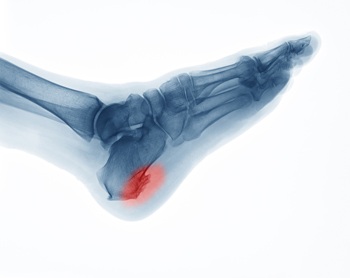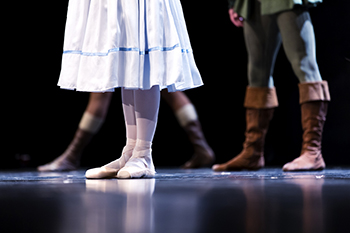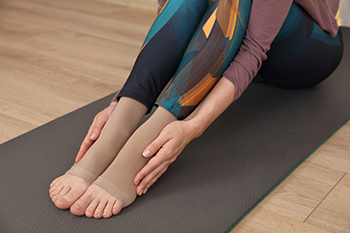Items filtered by date: July 2022
Standing All Day at Work Can Harm Your Feet

Hairdressers, restaurant line cooks and servers, teachers, and warehouse workers all have one thing in common—they spend a great part of their workday standing on their feet. This prolonged activity can result in chronic pain and discomfort in the feet, legs, and back. The first line of defense against foot pain caused from prolonged standing is proper footwear. Experts suggest shoes with a flatter heel that offer ample arch support. If you stand on hard surfaces, extra cushioning should be considered while choosing your shoes. Insoles or custom orthotics may be necessary to correct any ongoing conditions that may contribute to pain or fatigue. Shoes that breathe can help to prevent infections that thrive in moist environments. High heels should be avoided. It is also recommended that regular stretching exercises help blood circulate to the feet. Losing weight can reduce the pressure felt in the feet and legs, and it can help to keep joints healthy. Paying attention to your posture can aid in distributing your weight evenly and avoiding future leg and back problems. And finally, rest your feet when you can—taking breaks at work when possible and elevating them at home. If your foot pain becomes persistent, even when at rest, it is a good idea to consult a podiatrist for guidance and further treatment options.
While working on the feet, it is important to take the proper care of them. For more information about working on your feet, contact Leonora Fihman, DPM from California. Our doctor will treat your foot and ankle needs.
Working on Your Feet
Standing on your feet for long periods of time can cause stress and pain in your feet. Your whole body may experience change in terms of posture, back pain, bunions, callouses and or plantar warts. There are ways to avoid these conditions with proper foot care, smart choices and correct posture.
Positive Changes
Negative heeled shoe – Choosing this shoe type places the heel slightly lower than the ball of the foot. These are great for overall foot health. Find shoes that fit you correctly.
Go barefoot – Our feet were not designed to be enclosed for all hours of the day. Try to periodically expose your feet to air.
Eliminate Pain
Foot Exercises – Performing simple exercises, incorporating yoga and doing stretches are beneficial. This will allow increased blood flow to the area and muscles of the foot.
Achilles tendon – Stretching the foot out flat on the floor will relax the calf muscles and tendon. These exercises can be performed almost anywhere. Make sure you add these exercises to your daily regimen.
With a little bit of this information and knowing more about foot health, you will notice changes. Foot stretches and proper footwear will help with pain and prevent further issues.
If you have any questions please feel free to contact our offices located in Encino and Brentwood, Los Angeles, CA . We offer the newest diagnostic and treatment technologies for all your foot and ankle needs.
Preventing Heel Spurs

Anyone who cares about keeping their feet in a healthy condition ought to be aware of ways they can prevent heel spurs. This troublesome condition essentially causes a bony outgrowth on the bottom of the foot made up of calcium. Not all cases of heel spurs cause the patient pain. However, some heel spurs can be associated with severe pain from plantar fasciitis. If you are someone who wants to be diligent about preventing the onset of heel spurs, there are a number of steps that you can take. First, you can follow a sensible diet and successfully manage your weight. This is because the heavier you are, the more weight you are placing on your heel when walking, which can increase the likelihood of heel spurs. Additionally, you can be mindful of the surfaces on which you are walking and running. For example, if you are someone who walks or runs frequently, you can choose to do these activities on surfaces that are not hard, as this tends to ultimately wear down the heel. Lastly, you can avoid footwear that puts added strain on your heel, making you more susceptible to developing heel spurs. Such footwear includes flip flops and high heels. If you want to know about more ways in which you can avoid developing heel spurs, please see a podiatrist who can be able to help.
Heel spurs can be incredibly painful and sometimes may make you unable to participate in physical activities. To get medical care for your heel spurs, contact Leonora Fihman, DPM from California. Our doctor will do everything possible to treat your condition.
Heels Spurs
Heel spurs are formed by calcium deposits on the back of the foot where the heel is. This can also be caused by small fragments of bone breaking off one section of the foot, attaching onto the back of the foot. Heel spurs can also be bone growth on the back of the foot and may grow in the direction of the arch of the foot.
Older individuals usually suffer from heel spurs and pain sometimes intensifies with age. One of the main condition's spurs are related to is plantar fasciitis.
Pain
The pain associated with spurs is often because of weight placed on the feet. When someone is walking, their entire weight is concentrated on the feet. Bone spurs then have the tendency to affect other bones and tissues around the foot. As the pain continues, the feet will become tender and sensitive over time.
Treatments
There are many ways to treat heel spurs. If one is suffering from heel spurs in conjunction with pain, there are several methods for healing. Medication, surgery, and herbal care are some options.
If you have any questions feel free to contact our offices located in Encino and Brentwood, Los Angeles, CA . We offer the latest in diagnostic and treatment technology to meet your needs.
Plantar Fasciitis in Dancers

Although almost anyone can develop plantar fasciitis, some individuals are at a greater risk of exhibiting this foot ailment. One such higher risk group includes dancers. Plantar fasciitis is a foot condition that causes heel pain. It is caused by the inflammation of the plantar fascia that runs from the toes to the heel. Those suffering from plantar fasciitis typically experience sharp pain in the heel, tight Achilles tendons, and pronounced pain when beginning to walk after extended periods of rest. Dancers can be at a higher risk of experiencing plantar fasciitis because they engage in large amounts of physical activity wearing high heels and often exert themselves without taking adequate breaks. If dancers do not properly stretch their feet before dancing, they are more susceptible to developing plantar fasciitis. There are a number of steps that dancers can take to reduce their chances of experiencing plantar fasciitis. Namely, dancers can focus on stretching the Achilles tendon before and after dancing. Dancers might opt for the runner’s stretch, heel drops, or the downward facing dog. If you are a dancer, you might want to be proactive in protecting the health of your feet by consulting a podiatrist.
Plantar fasciitis can be very painful and inconvenient. If you are experiencing heel pain or symptoms of plantar fasciitis, contact Leonora Fihman, DPM from California. Our doctor can provide the care you need to keep you pain-free and on your feet.
What Is Plantar Fasciitis?
Plantar fasciitis is the inflammation of the thick band of tissue that runs along the bottom of your foot, known as the plantar fascia, and causes mild to severe heel pain.
What Causes Plantar Fasciitis?
- Excessive running
- Non-supportive shoes
- Overpronation
- Repeated stretching and tearing of the plantar fascia
How Can It Be Treated?
- Conservative measures – anti-inflammatories, ice packs, stretching exercises, physical therapy, orthotic devices
- Shockwave therapy – sound waves are sent to the affected area to facilitate healing and are usually used for chronic cases of plantar fasciitis
- Surgery – usually only used as a last resort when all else fails. The plantar fascia can be surgically detached from the heel
While very treatable, plantar fasciitis is definitely not something that should be ignored. Especially in severe cases, speaking to your doctor right away is highly recommended to avoid complications and severe heel pain. Your podiatrist can work with you to provide the appropriate treatment options tailored to your condition.
If you have any questions please feel free to contact our offices located in Encino and Brentwood, Los Angeles, CA . We offer the newest diagnostic and treatment technologies for all your foot and ankle needs.
Reasons for and Symptoms of Poor Circulation

Poor circulation is a serious ailment that has several symptoms. It occurs when blood flow is restricted and can happen for various reasons. One of these is diabetes, as a result of elevated blood sugar levels. Nerve damage may result, the feet can have a tingling sensation, and they may lose feeling completely. Additional reasons include a possible blood clot, which may block blood flow. Patients who smoke may be at an increased risk for poor circulation, which can aid in damaging the blood vessels. Symptoms associated with poor circulation include cold extremities, swollen feet, and poor digestion. Normal blood flow is crucial in having proper digestion, and symptoms of this include abdominal pain, diarrhea, or cramping. Poor circulation for any reason is not to be taken lightly, and the feet can be negatively affected. It is suggested that you are under the care of a podiatrist who can treat poor circulation.
While poor circulation itself isn’t a condition; it is a symptom of another underlying health condition you may have. If you have any concerns with poor circulation in your feet contact Leonora Fihman, DPM of California. Our doctor will treat your foot and ankle needs.
Poor Circulation in the Feet
Peripheral artery disease (PAD) can potentially lead to poor circulation in the lower extremities. PAD is a condition that causes the blood vessels and arteries to narrow. In a linked condition called atherosclerosis, the arteries stiffen up due to a buildup of plaque in the arteries and blood vessels. These two conditions can cause a decrease in the amount of blood that flows to your extremities, therefore resulting in pain.
Symptoms
Some of the most common symptoms of poor circulation are:
- Numbness
- Tingling
- Throbbing or stinging pain in limbs
- Pain
- Muscle Cramps
Treatment for poor circulation often depends on the underlying condition that causes it. Methods for treatment may include insulin for diabetes, special exercise programs, surgery for varicose veins, or compression socks for swollen legs.
As always, see a podiatrist as he or she will assist in finding a regimen that suits you. A podiatrist can also prescribe you any needed medication.
If you have any questions, please feel free to contact our offices located in Encino and Brentwood, Los Angeles, CA . We offer the newest diagnostic and treatment technologies for all your foot care needs.

